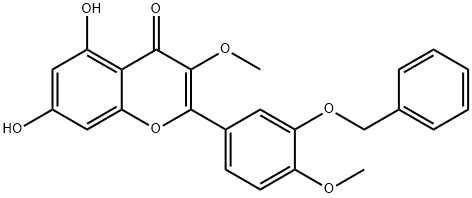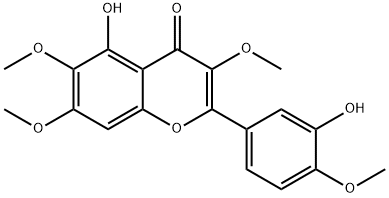3-O-Methylquercetin
Synonym(s):5,7,3′ ,4′ -Tetrahydroxy-3-methoxyflavone;Quercetin 3-O-methyl ether
- CAS NO.:1486-70-0
- Empirical Formula: C16H12O7
- Molecular Weight: 316.26
- MDL number: MFCD00210588
- EINECS: 200-258-5
- SAFETY DATA SHEET (SDS)
- Update Date: 2024-11-19 15:53:33

What is 3-O-Methylquercetin?
Description
3-O-Methylquercetin is a metabolite in flavone and flavonol biosynthesis. It is a naturally occurring compound present in various plants, and was shown to have potent anticancer-promoting, antioxidant, antiallergy, and antimicrobial activity, and showed strong anti-viral activity inhibition of tomato ringspot virus.
3-O-Methylquercetin significantly inhibits cyclic adenosine monophosphate- (cAMP-) and cyclic guanosine monophosphate- (cGMP-) phosphodiesterase activity. It possess anti-inflammatory, bronchodilating properties and used in treatment of asthma. It suppresses the total inflammatory cells, tumor necrosis factor-α (TNF-α) and attenuates the production of interleukins.
The Uses of 3-O-Methylquercetin
A metabolite of the flavanoid Quercetin (Q509500) with inhibitory activity on lipopolysaccharide-induced activation of macrophage U937 cells.
What are the applications of Application
3-O-Methyl Quercetin is A metabolite of the flavanoid Quercetin (sc-206089)
Definition
ChEBI: A tetrahydroxyflavone having the 4-hydroxy groups located at the 3'- 4'- 5- and 7-positions as well as a methoxy group at the 2-position.
Biological Activity
3-O-Methylquercetin isolated from the herbs of Croton cascarilloides. It is a selective and competitive PDE3/PDE4 inhibitor,and inhibits PDE3 than PDE4 with a low K(m) value; it inhibits total cAMP- and cGMP-phosphodiesterase (PDE) of guinea pig trachealis at low concentrations.
Biochem/physiol Actions
3-O-Methylquercetin is a metabolite in flavone and flavonol biosynthesis. It is a naturally occurring compound present in various plants, and was shown to have potent anticancer-promoting, antioxidant, antiallergy, and antimicrobial activity, and showed strong anti-viral activity inhibition of tomato ringspot virus.
Properties of 3-O-Methylquercetin
| Melting point: | 275 °C |
| Boiling point: | 643.0±55.0 °C(Predicted) |
| Density | 1.69±0.1 g/cm3(Predicted) |
| solubility | Soluble in Chloroform,Dichloromethane,Ethyl Acetate,DMSO,Acetone,etc. |
| form | powder |
| pka | 6.31±0.40(Predicted) |
| color | Yellow |
| BRN | 324509 |
| Stability: | Hygroscopic |
Safety information for 3-O-Methylquercetin
| Signal word | Danger |
| Pictogram(s) |
 Skull and Crossbones Acute Toxicity GHS06 |
| GHS Hazard Statements |
H301:Acute toxicity,oral |
| Precautionary Statement Codes |
P301+P310:IF SWALLOWED: Immediately call a POISON CENTER or doctor/physician. |
Computed Descriptors for 3-O-Methylquercetin
New Products
4-AMINO-TETRAHYDRO-PYRAN-4-CARBOXYLIC ACID HCL 4-(Dimethylamino)tetrahydro-2H-pyran-4-carbonitrile 4-Aminotetrahydropyran-4-carbonitrile Hydrochloride (R)-3-Aminobutanenitrile Hydrochloride 3-((Dimethylamino)methyl)-5-methylhexan-2-one oxalate 1,4-Dioxa-8-azaspiro[4.5]decane 5-Bromo-2-nitropyridine Nimesulide BP Aceclofenac IP/BP/EP Diclofenac Sodium IP/BP/EP/USP Mefenamic Acid IP/BP/EP/USP Ornidazole IP Diclofenac Potassium THOMAIND PAPER PH 2.0 TO 4.5 1 BOX BUFFER CAPSULE PH 9.2 - 10 CAP SODIUM CHLORIDE 0.1N CVS ALLOXAN MONOHYDRATE 98% PLATINUM 0.5% ON 3 MM ALUMINA PELLETS (TYPE 73) LITHIUM AAS SOLUTION 2-Bromo-1-(bromomethyl)-3-chloro-5-nitrobenzene 2-Bromo-3-nitroaniline N-(3-Hydroxypropyl)-N-methylacetamide 3-Bromo-6-chloropyridazine 4-ethyl-3-nitrobenzoic acidRelated products of tetrahydrofuran








You may like
-
 3-O-Methylquercetin CAS 1486-70-0View Details
3-O-Methylquercetin CAS 1486-70-0View Details
1486-70-0 -
 1-Methyl-6-oxo-1,6-dihydropyridazine-3-carbonitrile 98%View Details
1-Methyl-6-oxo-1,6-dihydropyridazine-3-carbonitrile 98%View Details
99903-60-3 -
 1823368-42-8 98%View Details
1823368-42-8 98%View Details
1823368-42-8 -
 2-(3-(tert-butyl)phenoxy)-2-methylpropanoic acid 1307449-08-6 98%View Details
2-(3-(tert-butyl)phenoxy)-2-methylpropanoic acid 1307449-08-6 98%View Details
1307449-08-6 -
 Ethyl 3-(furan-2-yl)-3-hydroxypropanoate 25408-95-1 98%View Details
Ethyl 3-(furan-2-yl)-3-hydroxypropanoate 25408-95-1 98%View Details
25408-95-1 -
 2-Chloro-5-fluoro-1-methoxy-3-methylbenzene 98%View Details
2-Chloro-5-fluoro-1-methoxy-3-methylbenzene 98%View Details
1805639-70-6 -
 1784294-80-9 98%View Details
1784294-80-9 98%View Details
1784294-80-9 -
 Lithium ClavulanateView Details
Lithium ClavulanateView Details
61177-44-4